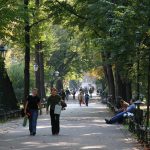 A recent study from Texas A&M University suggests that people living in cities who have more exposure to urban green spaces tend to use fewer mental health services.
A recent study from Texas A&M University suggests that people living in cities who have more exposure to urban green spaces tend to use fewer mental health services.
To measure urban greenness, the researchers employed NatureScore, a tool that considers various factors such as air, noise, and light pollution, parks, and tree canopies. It calculates the quantity and quality of natural elements for any known address in the United States and other countries. NatureScore provides scores ranging from 0-19 points for Nature Deficient to 80-100 for Nature Utopia.
Mental health
The researchers then gathered data on mental health visits at the ZIP code level from Texas Hospital Outpatient Public Use Data Files covering the period from 2014 to mid-2019. This data included details like patient age, gender, race/ethnicity, education, employment status, poverty level, principal diagnosis, and ZIP code, while ensuring patient identities remained confidential.
“The association between exposure to nature and better mental health is well established in the United States and elsewhere, but most studies use just one or two measurements of this exposure,” the researchers explain.
“Our study was the first to use NatureScore, which provides more complex data, to study the correlation between urban nature exposure and mental health.”
Testing health
The researchers analyzed a substantial dataset of 61,391,400 adult outpatient encounters in Texas cities related to depression, bipolar disorders, stress, and anxiety. The data covered 1,169 ZIP codes in urban Texas, with a median NatureScore of 85.8. Approximately half of the sample had high NatureScores (80+), while around 22% had NatureScores below 40.
Breaking down the encounters, 63% involved women, 30% were individuals aged 65 or older, 54% were non-Hispanic white, and 15% were Hispanic. At the ZIP code level, 27% of the total population had a bachelor’s degree, 58% were employed, 14% lived under poverty, and 17% lacked health insurance coverage.
ZIP codes with higher NatureScores tended to have a higher percentage of people aged 65 and older, non-Hispanic white residents, Hispanic residents, and those who were employed. Conversely, areas with higher NatureScores had lower percentages of Black residents, individuals living in poverty, or lacking insurance.
Boosting mental health
The study observed a consistent trend: as the NatureScore of a neighborhood increased, the rates of various mental health encounters decreased. Neighborhoods with NatureScores over 60 exhibited mental health encounter rates about 50% lower.
Notably, individuals living in neighborhoods with the highest NatureScore categories—Nature Rich and Utopia—experienced significantly lower rates of mental health encounters compared to those in neighborhoods with the lowest NatureScore category.
“We found that a NatureScore above 40—considered Nature Adequate—seems to be the threshold for good mental health,” the authors conclude. “People in these neighborhoods have a 51% lower likelihood of developing depression and a 63 % lower likelihood for developing bipolar disorders.”